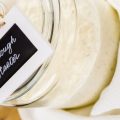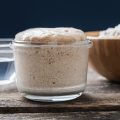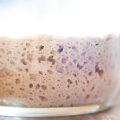Have you ever wondered where the liquid on top of your sourdough starter has come from? That liquid is called hooch, and if you’re an avid sourdough baker you probably know what I’m talking about. Before you fight the hooch, you have to understand the sourdough starter liquid’s existence. I’ll be sharing everything I know about the hooch on a sourdough starter, so sit tight!
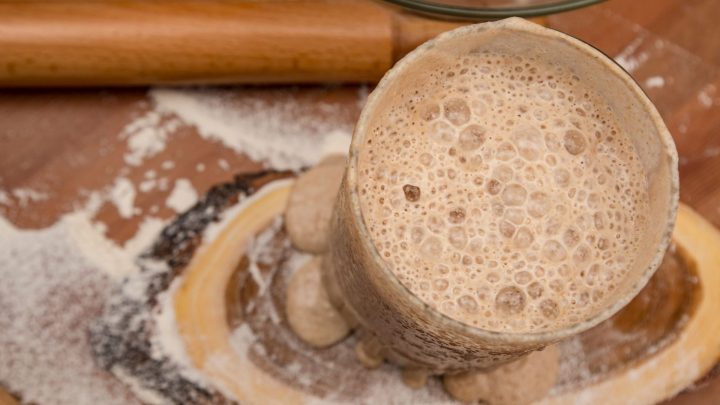
Table of Contents
- Why Does My Sourdough Starter Have Liquid On Top?
- What Color is Hooch?
- How to Prevent Sourdough Starter From Forming Hooch?
- Can I Drink Hooch?
- How Much Should I Feed My Starter?
- Can I Use Different Flours to Feed My Starter?
- How to Make a Sourdough Starter?
- Sourdough Hooch
- Sourdough Starter Liquid FAQs
Why Does My Sourdough Starter Have Liquid On Top?
Hooch is the liquid that forms atop your sourdough starter during its early days.
A sourdough starter is a simple combination of ingredients, involving equal parts flour and water. The flour is mixed with the water until a smooth paste has formed, then the mixture is loosely covered and set aside to ferment. You may notice a pool of liquid forming on the surface of your sourdough starter. Sometimes this liquid can form underneath or even in the middle of your starter.
This liquid is called hooch, and it forms when your starter has run out of food, indicating that it is hungry! The hooch on top of the sourdough starter is actually a type of alcohol and is a by-product of the fermentation process that occurs within your starter.
Should I Pour the Liquid off My Sourdough Starter?
No, you should resist the temptation of pouring the liquid off your sourdough starter.
The hooch is an essential element of your starter’s hydration, meaning that it will alter the hydration levels of your sourdough starters. Moreover, the hooch provides an enhanced sourdough flavor that is especially great for your sourdough loaves.
If you find that your starter has begun to produce hooch, simply mix the hooch back into the starter before you discard half and feed the starter. If your sourdough starter has been stored in the fridge for a long time, and there is a pool of dark liquid collecting on the surface of the starter, then you may want to pour this off.
What Color is Hooch?
Hooch has many colors. Each with its own tiny tale.
As your sourdough starter matures, you’ll notice it begins to change color. A starter that has been in the fridge for a long time will develop a dark liquid that can be brown, black, or even purple.
These colors are completely normal and will not affect your starter. Simply stir the liquid back into the starter jar. The only time you should dispose of your sourdough starter is if it has developed mold.
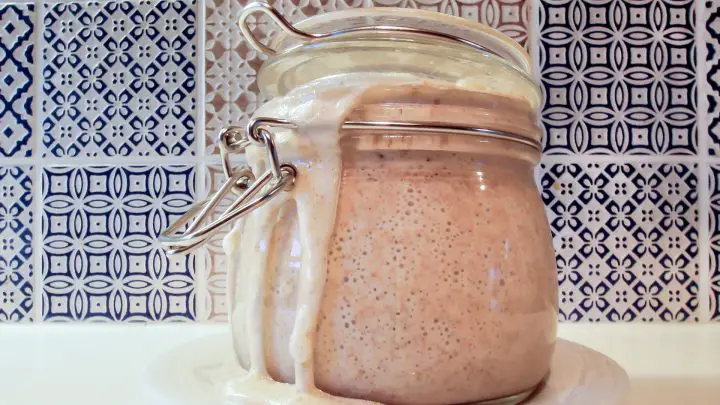
How to Prevent Sourdough Starter From Forming Hooch?
To minimize the appearance of hooch on your starter, you’ll need to switch up a few things.
While hooch is both harmless, and positive it indicates that your starter is hungry, meaning that you must increase its food, or prevent it from consuming the food quickly.
Some of the things you can do to help prevent your starter from forming hooch can include:
- Increased feeding – Follow a regular feeding schedule and feed your starter every 12 hours instead of every 24 hours.
- Move the starter to a cooler spot, as warmer temperatures will encourage the enzymes in your starter to feed at a quicker pace. Keeping the starter at 70 degrees F or lower will ensure that they eat a little slower.
- Feed your starter with a higher ratio of flour and water. So instead of 1:1:1, try 1:2:2 i.e., for 25g of starter feed it 50g of flour and 50g of water.
- Use a different flour – While most sourdough starters are great when fed with all-purpose flour, some aren’t. If you want to bake bread successfully you’ll have to experience trial and error before you hit perfection! You can use bread flour, whole wheat flour, rye flour, spelt flour, wheat flour, or rice flour. Check out my post on the best sourdough starter flour to use.
Can I Drink Hooch?
Although there’s nothing wrong with drinking hooch, the real question is why would you want to?
I get it, once your sourdough starter starts to release these alien smells like nail polish remover, you start to get a little excited, and have the urge to taste the liquid on top of your starter.
My advice would be – don’t. Simply mix the hooch back into the starter, discard some, then feed the remaining starter.
How Much Should I Feed My Starter?
If you’re not feeding your starter regularly then this can cause some issues
. When it comes to feeding your starter, don’t focus on the quantity of flour and water, rather work towards increasing the volume of your starter after each feed. This increase will determine the readiness of your starter, order to bake great sourdough bread. As your starter increases in volume, you’ll need to increase its feeding. The more starter you have the more flour and water it will need.
For instance, if you have half a cup of sourdough starter, then you’ll need to feed it with a quarter cup of flour, and a quarter cup of water. This will ensure that your starter doubles in volume.
For accurate hydration levels, weigh your flour and water before adding it to your starter.
Here’s an example of how to do this:
- Step 1 – Place the starter jar on some weighing scales set to zero.
- Step 2 – Add in half its volume of flour, and jot down the added weight of the mixture in the jar.
- Step 3 – Feed it the exact weight of water as flour.
This ensures that your sourdough starter remains at a comfortable 100% hydration. For a lower hydration level, you’ll need to feed your sourdough starter with more flour than water, and this may result in a thicker starter. If you’d like to learn more about sourdough hydration levels check out sourdough hydration process.
What If I Can’t Feed The Starter?
A common question amongst those that have just begun their sourdough journey, is what to do if you are unable to feed your starter.
And the answer to this is simple: place your starter in the refrigerator. Placing your starter in the fridge will slow down its fermentation rate, meaning that it will require less feeding.
If you’re wondering how to store your sourdough starter in the fridge then follow the step-by-step instructions outlined below:
- Step 1 – Refresh your sourdough starter then place it in a clean glass jar, preferably one that comes with a lid, and ensure that there is enough space in the jar for the starter to rise up.
- Step 2 – Close the jar by tightening the lid.
- Step 3 – Place the jar with the starter in the fridge.
You can also learn how to store sourdough starter for long-term storage.
Can I Use Different Flours to Feed My Starter?
Generally, a sourdough starter should be fed with the same flour each time. This will help you understand the behavior of your starter, in the way it responds to each feed, as well as determine the readiness of your sourdough starter. It also helps the natural bacteria and yeasts in your sourdough starter to remain set and comfortable.
However, if you happen to run out of flour at any point, then you can certainly replace it with a different flour.
Can I Change The Flour For My Starter Permanently?
If you’re considering a permanent change of flour for your starter, then simply make the switch during the next feed. Your starter may take some time to get used to the new flour, so it’s best to stick to a routine, as well as keep an eye on your starter during this period.
Your starter should effectively adjust to the new flour, and it should be ready to use.

How to Make a Sourdough Starter?
To make a sourdough starter you’ll need the simplest of ingredients. Maintaining your starter comes with its own responsibility.
Firstly, you’ll need to ensure that you’re feeding your starter regularly, so that it can quickly become established, and ready to use within a week. You’ve got to treat your starter like your child, and take care of it as if it is a part of you.
The video below will help you create a sourdough starter from scratch.
Good luck!
Sourdough Hooch
While hooch isn’t always a good sign, it isn’t necessarily a bad one either. So next time you find your sourdough starter with a dribble of liquid on its surface, simply mix, discard and feed. And remember to feed your starter regularly, so that the amazing bacteria can continue to thrive!
Sourdough Starter Liquid FAQs
Should I Pour Off The Hooch From My sourdough Starter?
Hooch is a harmless liquid on top of a sourdough starter and should be poured off and discarded before stirring and feeding the starter.
Why is My Sourdough Starter Making Hooch?
Hooch is the liquid that pools atop your sourdough starter when it hasn’t been fed in a while. The hooch isn’t dangerous, but rather an indication that your starter is hungry.
Does Hooch Make Sourdough More Sour?
Hooch imparts a sour flavor. Some bakers choose to pour it off before feeding the starter, however, others opt to mix the liquid back into the starter during feeding to ensure a perfectly tangy sourdough loaf.

